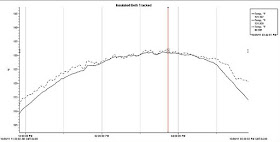Unlike the previous tests, here the flat plate shows a slight advantage over the concentrator. The flat plate begins heating more quickly and cools less quickly. During the period around solar noon, the curves are virtually the same. Overall, the curves are pretty close, suggesting that the characteristics of the two collectors are very similar when used in this configuration.
Early in the test, I had a problem with the temperature sensor for the concentrator. Fortunately, I had a look at the data being logged at about 09:45 and was able to correct the sensor problem just in time as the sun hit both collectors. You can probably get an idea of the concentrator temperature during this period by joining the tops of the readings. After the sun hits, the data is clean.
This is an enlargement of the period around solar noon. The curves are virtually identical, usually within a degree F. As in the previous test, the tracker reaches it's western limit just after 16:00 and the concentrator collectors falls out of the beam about 30 minutes later. The flat plate does not fall in temperature as quickly since it is still picking up some heat until the sun sets.
The maximum for both is pretty hard to pick out. The actual peak for the flat plate of 131.939F occurs at 15:43 which is 51.4 degrees F above ambient. At that time, the concentrator is 131.107F, within one degree F or virtually the same.
Index - Comparing concentrator to flat plate solar collector




Hello George,
ReplyDeleteI read all of your 4 test, and also the results. And I enjoy it.
I am wondering if you could make one more test, resemble with the last test you have made (both insulated and track) but with a slight different that is you put enclosure on the concentrated one.
The idea is I read on the graph that flat plate begins heating more quickly and cools slower than concentrated, so I guess if there is enclosure on the concentrated one, it might also heats quicker and cools slower than one without enclosure.
cheers,
Richard
Hello George,
ReplyDeleteI read all of your 4 test, and also the results. And I enjoy it.
I am wondering if you could make one more test, resemble with the last test you have made (both insulated and track) but with a slight different that is you put enclosure on the concentrated one.
The idea is I read on the graph that flat plate begins heating more quickly and cools slower than concentrated, so I guess if there is enclosure on the concentrated one, it might also heats quicker and cools slower than one without enclosure.
cheers,
Richard
Hello George,
ReplyDeletei am currently working on a solar collector which is a flat plate collector. my idea is to make a sandwich type one fin cum tube and only one inlet and out let i wonder is there any technique to increase heat transfer.
khalid
Sir, I genuinely believe that you have done a fantastic job regarding parabolic trough. Flate plate collectors and parabolic trough shows similar efficiencies and comparable heating action. Instead of using 5 evacuated tube will it be possible to replace it by using one evacuated tube and one parabolic trough. Household thermosyphone would have been far more cheaper if this was possible.
ReplyDelete